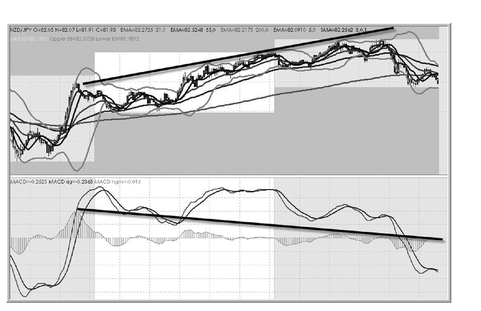BOLLINGER BANDS
As forex traders, we rely on market volatility as a means to profit. We want to see changes in a currency pair’s price. When the market produces a consistent, repeatable move up or down, we want to earn pips from that change in price level.
Volatility is the relative rate at which the price of a currency pair moves up and down. In other words, it’s the amount of price change over a period of time. If price moves up and down rapidly over short time periods, the market has high volatility. If the price changes very little, the market is exhibiting low volatility.
As you’ve probably noticed, if you’ve stared at your charts long enough, the forex market tends to find itself in one of two basic conditions: range bound or trending. By some estimates, the market is actually range bound about 70 to 80 percent of the time. In this scenario, the bulls and bears are in a battle that neither side is really winning or losing.
FIGURE 1.5 Divergence in a MACD Histogram
Source: DealBook® 360 screen capture printed by permission. c 2008 by Global Forex Trading, Ada MI USA

Price action is back and forth, back and forth—much like a tennis match. While in a range, the market establishes a fairly consistent level of volatility. When price is trapped in this range-bound condition, we’d like to have an idea of where it is likely to reverse from up to down (or vice versa).
Get The FX Bootcamp Guide to Strategic and Tactical Forex Trading now with the O’Reilly learning platform.
O’Reilly members experience books, live events, courses curated by job role, and more from O’Reilly and nearly 200 top publishers.

